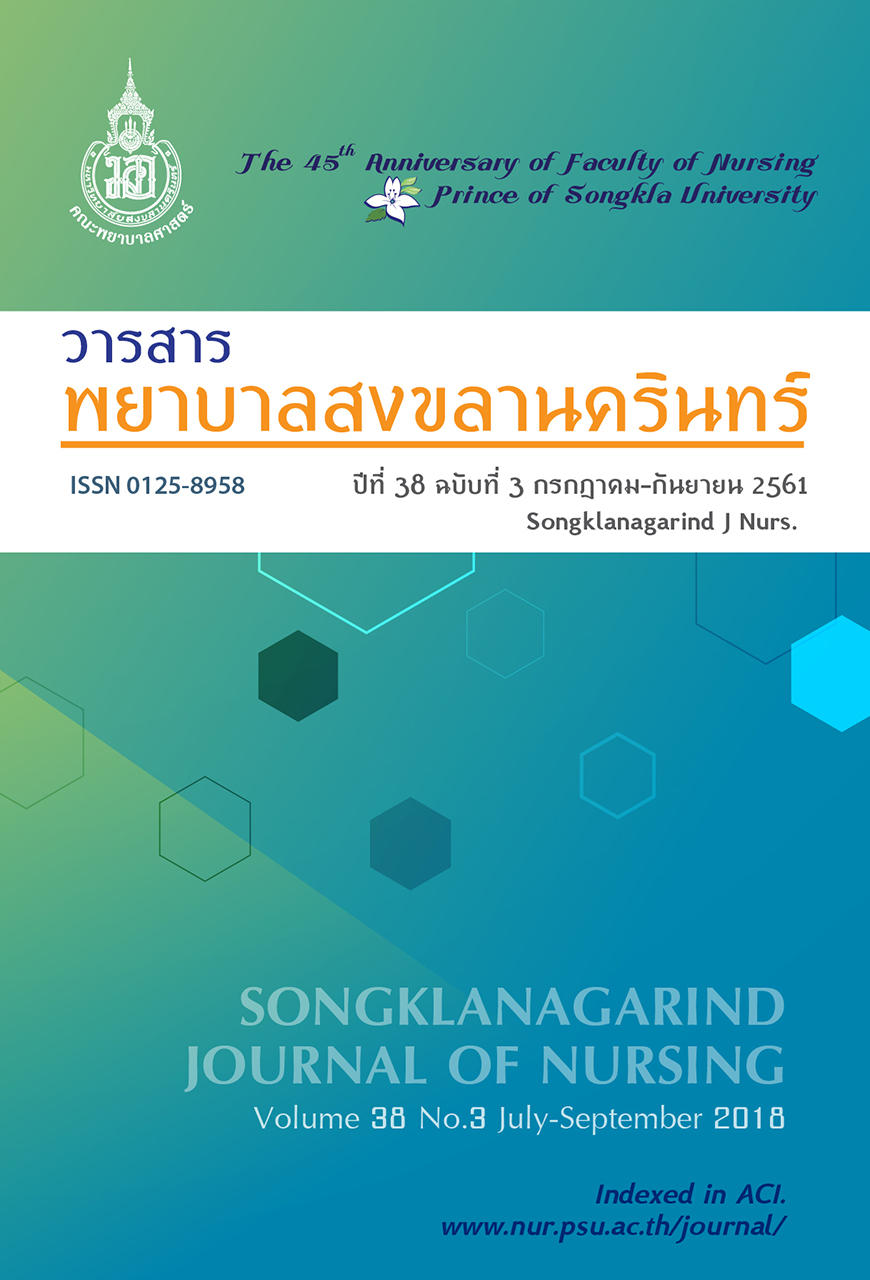Relationship Between Cardiac Rehabilitation Behaviors and Quality of Life Among Patients Post Coronary Artery Bypass Graft
Main Article Content
Abstract
This descriptive study aimed to investigate the relationship between cardiac rehabilitation behaviors and quality of life among patients post coronary artery bypass graft (CABG). The purposive sample consisted of 40 patients with CABG surgery of a tertiary hospital in southern Thailand, during 4-6 months postoperative. The data were collected by 1) the Demographic Data and Illness History Sheet, 2) the Cardiac Rehabilitation Behaviors for Patients Post-CABG Questionnaire, and 3) the Quality of Life for Patients Post-CABG Questionnaire, which were validated by three experts. The reliability of the cardiac rehabilitation behaviors questionnaire, and the quality of life questionnaire were examined and yielded Cronbach’s alpha coefficient of .77 and .93 respectively. The data were analyzed using descriptive statistics, Pearson product moment correlation, and Spearman rank correlation.
The results showed that the mean score of total cardiac rehabilitation behaviors of the subjects was at a high level (M=2.19, SD=0.41). The mean score of cardiac rehabilitation behaviors related to life modification behaviors was highest (M=2.57, SD=0.29) followed by stress management (Mdn=2.38, IQR=0.94) and exercise behaviors (M=1.75, SD=0.83). The mean score of the quality of life of the subjects was at a high level (M=24.00, SD=3.30). There were significantly positive correlation between the cardiac rehabilitation behaviors and the quality of life (r= .53, p< .001), and between exercise behaviors and the quality of life (r= .37, p< .05).
These findings showed that the cardiac rehabilitation behaviors, particularly exercise, had significant correlation with the quality of life. Therefore, the cardiac rehabilitation behaviors should focus on continuing exercise, in addition symptom management should be promoted for decreasing obstacle to perform cardiac rehabilitation behaviors in order to enhance the quality of life of coronary artery disease patients.
Article Details
References
2. Claes J, Buys R, Budts W, et al. Longer-term effects of home-based exercise interventions on exercise capacity and physical activity in coronary artery disease patients: A systematic review and meta-analysis. Eur J Preventive Cardiology. 2017; 24(3): 244-56. doi: 10.1177/2047487316675823.Epub 2016 Oct 27.
3. The Royal college of physiatrists of Thailand. Cardiac rehabilitation for patient with coronary artery disease. [Internet]. 2007 [cited 2013 Nov 28]. Available from: https://thaiheart.org/บทความสาระที่น่าสนใจ/guideline.html
4. Balady GJ, Williams MA, Ades PA, et al. Core components of cardiac rehabilitation/secondary prevention programs: 2007 update. Circulation.
2007; 115(20): 2675-82. doi: 10.1161/CIRCULATIONAHA.106.180945
5. Smith SC, Allen J, Blair SN, et al. AHA/ACC guidelines for secondary prevention for patients with coronary and other atherosclerotic vascular disease: 2006 update. Circulation. 2006; 113(19): 2363-72. doi: 10.1161/CIRCULATIONAHA.
106.174516
6. Kadechumpon K, Thumnong S, Buasri N. The Development of cardiac rehabilitation model for coronary artery disease patients in Sisaket Hospital. J Nurses Association of Thailand, North-Eastern Division. 2009; 27(4), 30-9. Thai.
7. Nakon O, Sindhu S, Tansawatdi R. Effectiveness of a hospital-based comprehensive cardiac rehabilitation program on postoperative recovery
of patients undergoing coronary artery bypass grafting. J Nurs Sci. 2015; 33(4), 51-64. Thai.
8. Thongmak K. Illness perceptions, receiving information and cardiac rehabilitation behaviors in patients with acute coronary dyndrome after
discharge [dissertation]. [Songkhla]: Prince of Songkla University; 2011. 92 p. Thai.
9. Kaewchuy K. The Effects of cardiac rehabilitation enhancing program on functional capability at home in patients with coronary heart disease
[dissertation]. [Songkhla]: Prince of SongklaUniversity; 2009. 111 p. Thai.
10. Ritpetch N, Jitpanya C. Factors related to quality of life among patients with heart disease: A research synthesis in Thailand. Thai J Cardio-Thoracic Nursing. 2012; 23(2): 2-16. Thai.
11. Intarat B. Effect of an Enhancing Self-efficacy in phase I cardiac rehabilitation program on physical fitness and satisfaction of patients with coronary artery bypass graft surgery [dissertation].[Songkhla]: Prince of Songkla University; 2013.
137 p. Thai.
12. Kobkitsumongkol K, Ura-Aree P, KantaratanakulV. Quality of life in open heart surgery at Ramathibodi Hospital. Thai J Cardio-Thoracic Nursing. 2009; 20(2): 46-56. Thai.
13. Suwanakitch P, Munmee T, Akarasaratool T,et al. Quality of life of patients after heartvalve replacement surgery. Buddhachinaraj Medical J. 2012; 29(1): 36-43. Thai.
14. Leewattana T, Isaramalai S, Punthusena C. Basic conditioning factors, self-care agency and quality of life of patients following open heart surgery. Songkla Med J. 2008; 26(2): 141-50. Thai.
15. Holzemer WL. The impact of nursing care in Latin America and the Caribbean: A focus on outcomes. J Adv Nurs. 1994; 20(1): 5-12.
16. Holzemer WL, Reilly CA. Variables variability and variations research: applications for medical Informations. J of American medical Informatics
Association. 1995; 2(3): 183-90. doi: https://doiorg/10.1136/jamia.1995.95338871
17. Ferrans CE, Powers MJ. Quality of life index:development and psychometric properties. Advances in nursing science. 1985; 8(1):15-24. doi: https://
dx.doi.org/10.1097/00012272-198510000-00005
18. Polit DF & Beck CT. Nursing research:Generating and assessing evidence for nursing practice. Philadelphia: Lippincott Williams &Wilkins. 2012.
19. Tongteam W, JitiPunya C, Tuntikosum P. Relationships among Post-operative Peroid, Symtom Frequency, Symtom Distress, Fear of Fall and Physical Activity in Patients Post Coronary Artery Bypass Graft. 2016; 8(1): 27-38. Thai.
20. Chaiwong N, Duangpaeng S, Masingboon. Factors influencing Self-management Behaviors among Acute Myocardiak Infarction Patients. Thai
Pharm Health Sci J. 2014; 9(3): 112-19. Thai.
21. Chamruksa P, Pravenawarakun S, Siristeanruj T.Quality of life in post cardiac valvular replacement patients. Princess of Narathivas University Journal.
2011; 3(2): 1-14. Thai.
22. Sirisatheanrooch T, Chittihavorn V, Maneewat K. Quality of life in the long-term of patients undergoing open-heart surgery; A case study at Songklanagarind Hospital. Songkla Med J. 2012; 23(1): 31-43. Thai.
23. Saengsiri A, Wattradul D, Kangchanakul S, et al. The factors inuencing the self-care agency and quality of life of patients with coronary artery disease. Thai Journal of Cardio-Thoracic Nursing. 2015; 26(1): 104-17. Thai.


